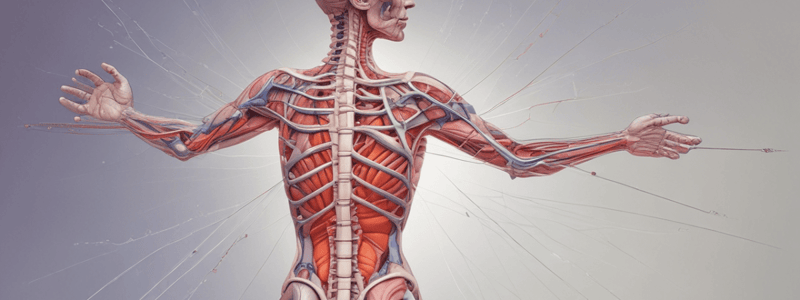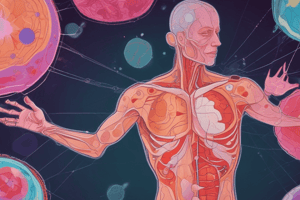Podcast
Questions and Answers
What type of stimuli can trigger an acute pain response?
What type of stimuli can trigger an acute pain response?
- Harmless stimuli
- Pleasant stimuli
- Damaging or potentially damaging stimuli (correct)
- Beneficial stimuli
What is the role of nociception in the body?
What is the role of nociception in the body?
- To detect and respond to harmful stimuli (correct)
- To regulate hunger and thirst
- To reduce inflammation
- To promote tissue repair
What is the primary outcome of an acute pain response?
What is the primary outcome of an acute pain response?
- Withdrawal from the harmful stimulus (correct)
- Increased sensitivity to stimuli
- Enhanced cognitive function
- Relaxation and reduced stress
What is the purpose of acute pain in the body?
What is the purpose of acute pain in the body?
What process involves the normal processing of pain and responses to harmful stimuli?
What process involves the normal processing of pain and responses to harmful stimuli?
What type of stimuli can trigger a response from nociceptors?
What type of stimuli can trigger a response from nociceptors?
What is the result of the body's response to acute pain?
What is the result of the body's response to acute pain?
What is the term for the receptors that detect noxious stimuli?
What is the term for the receptors that detect noxious stimuli?
What is the primary purpose of the physiological response of acute pain?
What is the primary purpose of the physiological response of acute pain?
What is the outcome of normal processing of pain and responses to noxious stimuli?
What is the outcome of normal processing of pain and responses to noxious stimuli?
What type of stimuli can trigger a response from nociceptors?
What type of stimuli can trigger a response from nociceptors?
What is the relationship between nociception and pain?
What is the relationship between nociception and pain?
What is the duration of the physiological response of acute pain?
What is the duration of the physiological response of acute pain?
What is the effect of tissue damage on nociceptors?
What is the effect of tissue damage on nociceptors?
What is the term for pain that results from a non-noxious stimulus?
What is the term for pain that results from a non-noxious stimulus?
What is the effect of NSAIDs on prostaglandins?
What is the effect of NSAIDs on prostaglandins?
What is the term for hypersensitivity to a noxious stimulus?
What is the term for hypersensitivity to a noxious stimulus?
What is released by tissue damage that increases the sensitivity of nociceptors?
What is released by tissue damage that increases the sensitivity of nociceptors?
Flashcards are hidden until you start studying
Study Notes
Acute pain is a physiological response that warns us of danger. Nociception - normal processing of pain and the responses to noxious stimuli that are damaging or potentially damaging to normal tissue.
Acute pain is a physiological response that warns us of danger. Nociception - normal processing of pain and the responses to noxious stimuli that are damaging or potentially damaging to normal tissue.
Acute pain is a physiological response that warns us of danger. Nociception - normal processing of pain and the responses to noxious stimuli that are damaging or potentially damaging to normal tissue.
Inflammatory Pain
- Tissue damage releases inflammatory mediators, including prostaglandins and bradykinin, which increase the sensitivity of nociceptors to noxious stimuli.
- This process leads to sensitization in the pain pathway, resulting in hyperalgesia (hypersensitivity to noxious stimuli).
- Hyperalgesia is characterized by hypersensitive nociceptors.
- In addition, inflammatory pain can cause allodynia, which is pain resulting from a non-noxious stimulus.
- Allodynia is mediated by the activation of low-threshold mechanoreceptors and thermoreceptors.
- NSAIDs (non-steroidal anti-inflammatory drugs) reduce the production of prostaglandins, which contributes to the alleviation of inflammatory pain.
Studying That Suits You
Use AI to generate personalized quizzes and flashcards to suit your learning preferences.


